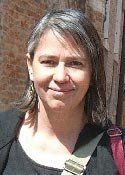Profiles of Women of EPA: Ann Richard

Ann Richard, Research Chemist
Office of Research and Development
Research Triangle Park, NC
Where were you born?
Worcester, Mass.
What brought you to EPA?
My husband and I had both just graduated with Ph. D.s when he landed a good job at NC State University. As is the case with many professional couples, I looked for a job locally and learned of a postdoctoral position available at EPA for a computational chemist. I was hesitant at first since this area of toxicology was pretty far from my original field of research. But having no other good prospects at the time, I jumped at the opportunity. I had no idea back in 1984 that it would define my new career path and I’d still be at EPA 32 years later!
What type of work do you do at EPA?
Most recently, I was a research scientist in EPA's Center for Computational Toxicology & Exposure until my retirement in March of 2023, after 36 years of service to EPA. I have returned to EPA as a volunteer Emeritus scientist to be a resource to former colleagues and younger scientists, and to help complete some past and current projects in my area of expertise and interest. Throughout my career, I used chemistry and computer modeling approaches to predict whether chemicals in the environment might cause harm to animals and people. I also have worked in what was a new field of "cheminformatics" in the early 2000's to the present, where it is now well established. I help to collect and analyze the structures and properties of hundreds of thousands of environmentally important chemicals and help to make this information available on a public EPA CompTox Dashboard website. As an Emeritus, I am continuing to provide chemistry support to EPA research programs that small quantities of chemicals are using robotics and plates the size of an iPhone instead of dosing animals. These new approaches have generated a very large datasets, consisting of up to 13,000 chemicals screened in hundreds of assays, generating rich datasets for modelers. This approach is called "computational toxicology" and is revolutionizing the way we do toxicity testing in the 21st century.
What is your highest level of education? What was your major?
My undergraduate degree is from SUNY Oswego, where I double-majored in chemistry and math. I earned a Ph.D. in physical chemistry from the University of North Carolina at Chapel Hill in 1983.
What message would you like to send other women who are considering college or a career in environmental protection?
My advice to women considering a career in environmental protection is to not limit themselves to “environmental studies,” but rather to follow their passion and aptitude first. Take advantage of internships and research opportunities along the way, whether in the fields of law, social sciences, chemistry, math, computer science, biology, or toxicology. In my view, it’s more important to first build on your strengths and interests, and then seek ways to apply your training and talents to the problems that most concern you. Environmental protection is a very large tent that requires a wide range of expertise and capabilities; so use an undergraduate course of study to build the skills, and then seek out one of the many doors to bring those skills into the tent.
